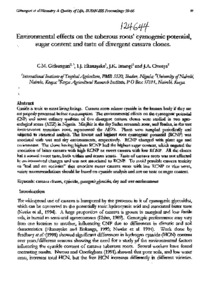| dc.contributor.author | Githunguri, C. |
| dc.contributor.author | Ekanayake, I. |
| dc.contributor.author | Imung, J. |
| dc.contributor.author | Chweya, J. |
| dc.date.accessioned | 2019-12-04T11:21:16Z |
| dc.date.available | 2019-12-04T11:21:16Z |
| dc.date.issued | 2000 |
| dc.identifier.citation | Githunguri, C., Ekanayake, I., Imung, J. & Chweya, J. (2000). Environmental effects on the tuberous roots' cyanogenic potential, sugar content and taste of divergent cassava clones. In Proceedings of the SUSAN-IBS scientific workshop,"Biometry and Quality of Life", 23-28 August, 1999, Ibadan, Nigeria: IITA, (p. 59-66). |
| dc.identifier.uri | https://hdl.handle.net/20.500.12478/3726 |
| dc.description.abstract | Cyanide is toxic to most living beings. Cassava roots release cyanide in the human body if they are not properly processed before consumption. The environmental effects on the cyanogenic potential (0.1» and some cuIinary qualities of five divergent cassava clones were studied in two agro-ecological zones (AEZ) in Nigeria. Minjibir in the dry Sudan savannah zone, and Ibadan, in the wet forest-savanna transition zone, represented the ABZs. Plants were sampled periodically and subjected to statistical analysis. The lowest and highest root cyanogenic potential (RCNP) was associated with wet and dry environments, respectively. RCNP changed with plant age and environment. The clone having highest RCNP had the highest sugar content, which negated the association of bitter cassava with high RC.l\lP or sweet cassava with low RCNP. And the clones had a normal sweet taste, both within and across zones. Taste of cassava roots was not affected by environmental changes and was not associated to RCNP. To avoid possible cassava toxicity on ''boil and eat societies" that associate sweet cassava roots with low RCNP or vice versa, variety recommendations should be based on cyanide analysis and not on taste or sugar content. |
| dc.language.iso | en |
| dc.subject | Cassava Clones |
| dc.subject | Cyanide |
| dc.subject | Cyanogenic Glycosides |
| dc.subject | Dry And Wet Environment |
| dc.subject | Genotypes |
| dc.subject | Post Harvest Technology |
| dc.title | Environmental effects on the tuberous roots cyanogenic potential, sugar content and taste of divergent cassava clones |
| dc.type | Conference Paper |
| dc.description.version | Peer Review |
| cg.contributor.affiliation | International Institute of Tropical Agriculture |
| cg.contributor.affiliation | University of Nairobi |
| cg.contributor.affiliation | Kenya Agricultural Research Institute |
| cg.coverage.region | Africa |
| cg.coverage.region | West Africa |
| cg.coverage.region | East Africa |
| cg.coverage.country | Nigeria |
| cg.coverage.country | Kenya |
| cg.authorship.types | CGIAR and developing country institute |
| cg.iitasubject | Cassava |
| cg.iitasubject | Plant Breeding |
| cg.iitasubject | Plant Production |
| cg.iitasubject | Smallholder Farmers |
| cg.iitasubject | Farm Management |
| cg.iitasubject | Diseases Control |
| cg.iitasubject | Plant Genetic Resources |
| cg.iitasubject | Livelihoods |
| cg.iitasubject | Post-Harvesting Technology |
| cg.iitasubject | Agribusiness |
| cg.iitasubject | Genetic Improvement |
| cg.iitasubject | Handling, Transport, Storage And Protection Of Agricultural Products |
| cg.iitasubject | Food Security |
| cg.iitasubject | Plant Diseases |
| cg.iitasubject | Pests Of Plant |
| cg.accessibilitystatus | Limited Access |
| local.dspaceid | 95881 |

